Want to make that golden, crisp-skinned Thanksgiving turkey of your dreams? Here's how to dry brine turkey. It's almost too easy, just follow my tutorial. I've been dry-bringing turkey for years. The skin comes out browned and crisp and the flavor of the meat is delicious and moist. You can do this!
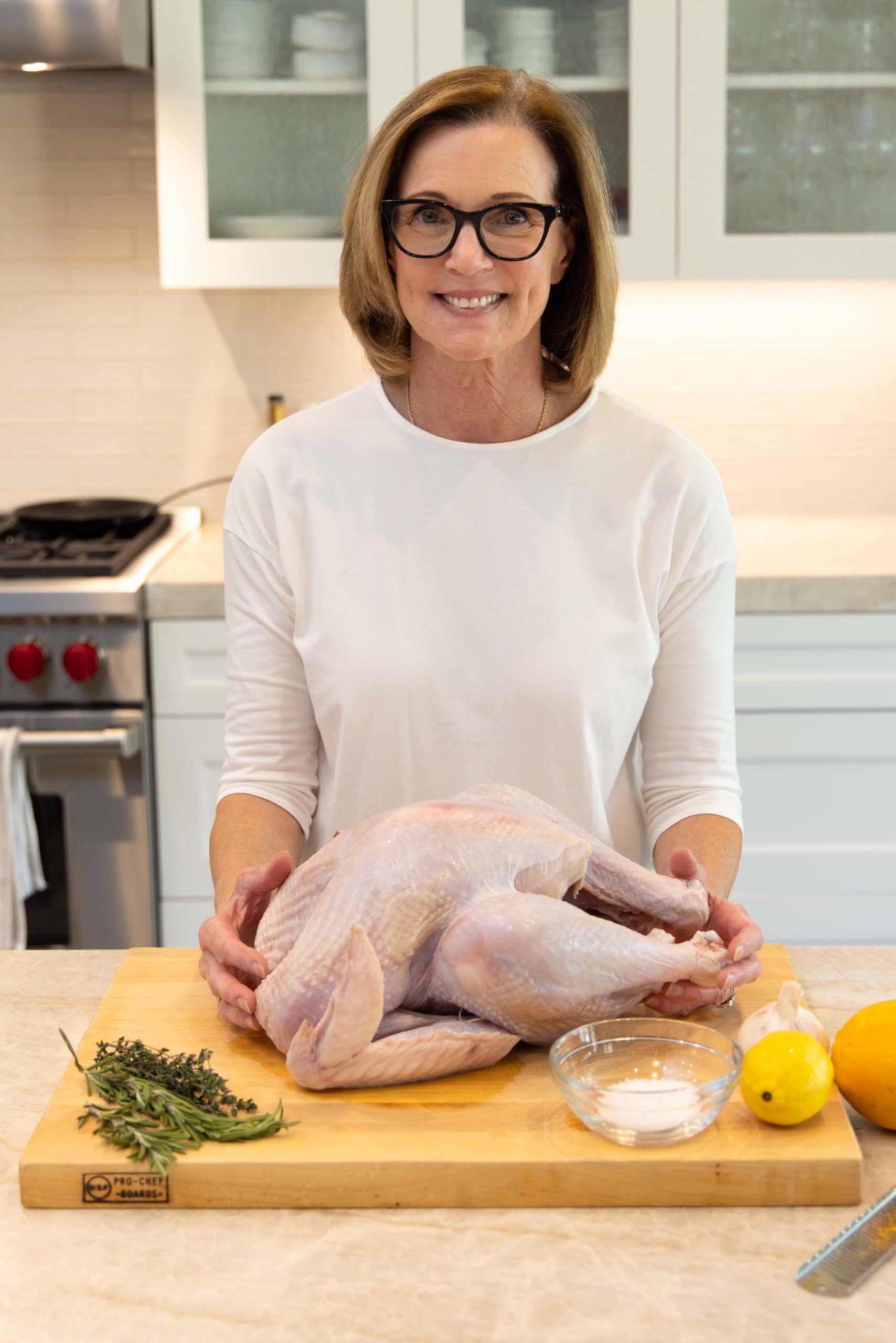
Once you discover dry brining you'll never look back. No more wet brining and dealing with a heavy bucket of brine and bird or the risk of soggy skin. At first I was skeptical because it was so simple. When I pulled that first glorious golden bird from the oven I was amazed. I think you will be too!
Jump to:
- Why You'll Like This Recipe
- Recipe Ingredients
- Recipe Instructions
- Make the Dry Rub
- Prepare The Turkey
- Dry Rub and Refrigerate
- Drying to Crisp Skin
- Get Ready to Roast
- How Much Turkey Per Person
- Fresh vs. Frozen Turkey
- How I Roast Turkey
- Recipe FAQs
- Recipe for Turkey Side Dishes
- ⭐️Did you Make This?
- 📖 Recipe
- 💬 Comments
Why You'll Like This Recipe
- It's EASY!
- The results are terrific.
- No handling buckets of wet brine.
Recipe Ingredients

- Turkey: Order a fresh 12-15 pound, no-salt-added raw, turkey, ahead of time to get what you want. See my tips below for how much turkey to buy.
- Salt: Wether you use a coarse sea salt or a fine pink sea salt does not matter when you measure. It seems like there would be a difference but I've weighed the salts and there is a tiny difference so don't worry about it. Choose what you prefer. I have both.
- Citrus: You need a fresh lemon and orange because you're after the zest. The zest is where all of the aromatic oils are in citrus fruit.
- Herbs: You need fresh rosemary and thyme. Fresh is better than dried for brining because the herbs are not dehydrated for storage; fresh provides the oils and flavors.
- Garlic: Instead of chopping fine, use the microplane zester. It works great on peeled fresh garlic cloves!
See recipe card for tools and for measurements.
Recipe Instructions
Combing the salt, zests, herbs and garlic creates your rub. Blend them well in a small bowl or grind together in a mortar and pestle. The amount of salt is based on the weight of the turkey. Use basically 1 tablespoon of salt for every 5 pounds of bird.
Make the Dry Rub
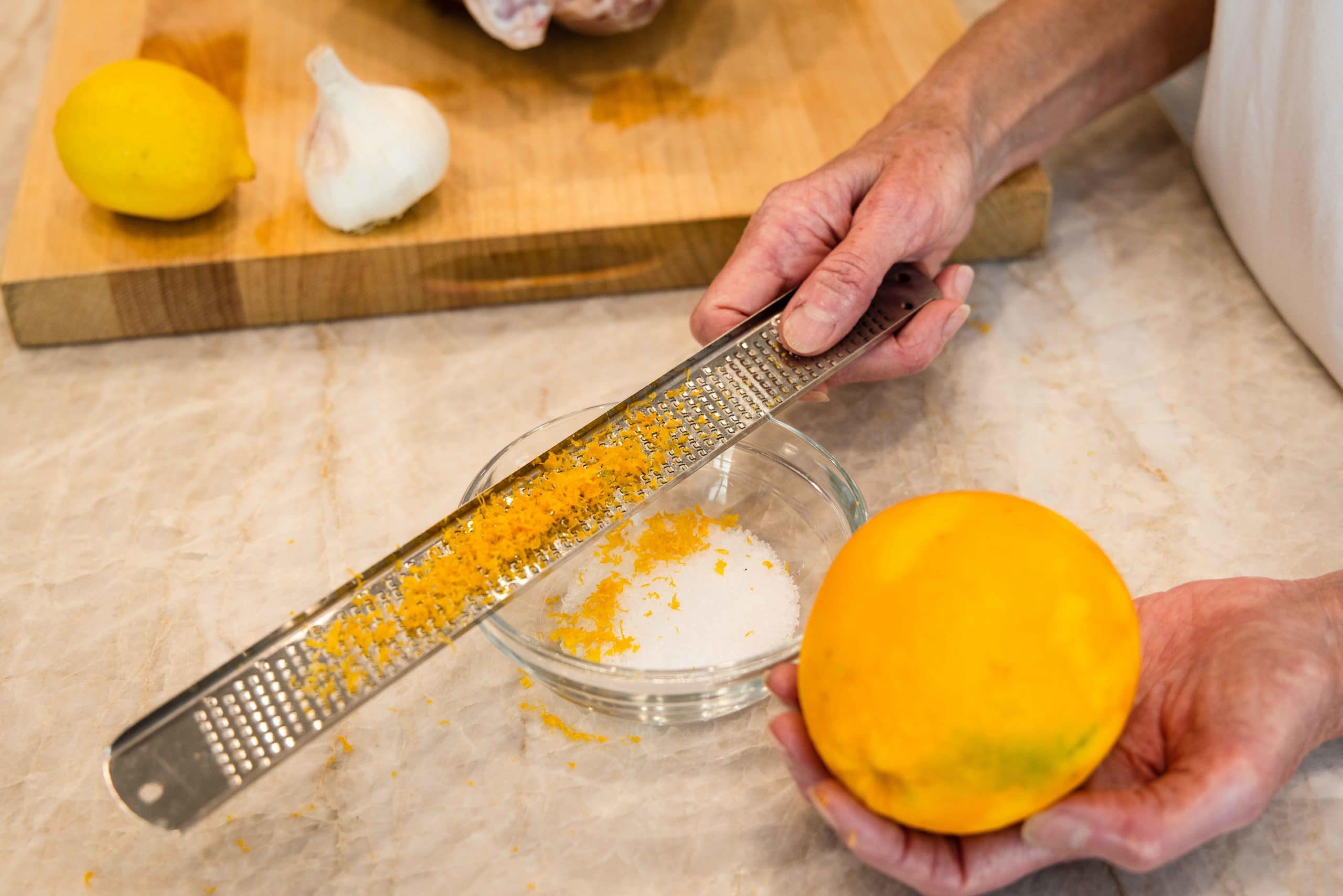

Prepare The Turkey
To dry brine, unwrap the turkey from the original plastic wrap and remove the bag of turkey parts from the cavity. Do this over a rimmed baking sheet or in the sink to catch any raw juices (and remember to sanitize your sink afterwards).
Trim off excess hanging skin at the tail. Pat the turkey dry inside and out with paper towels.
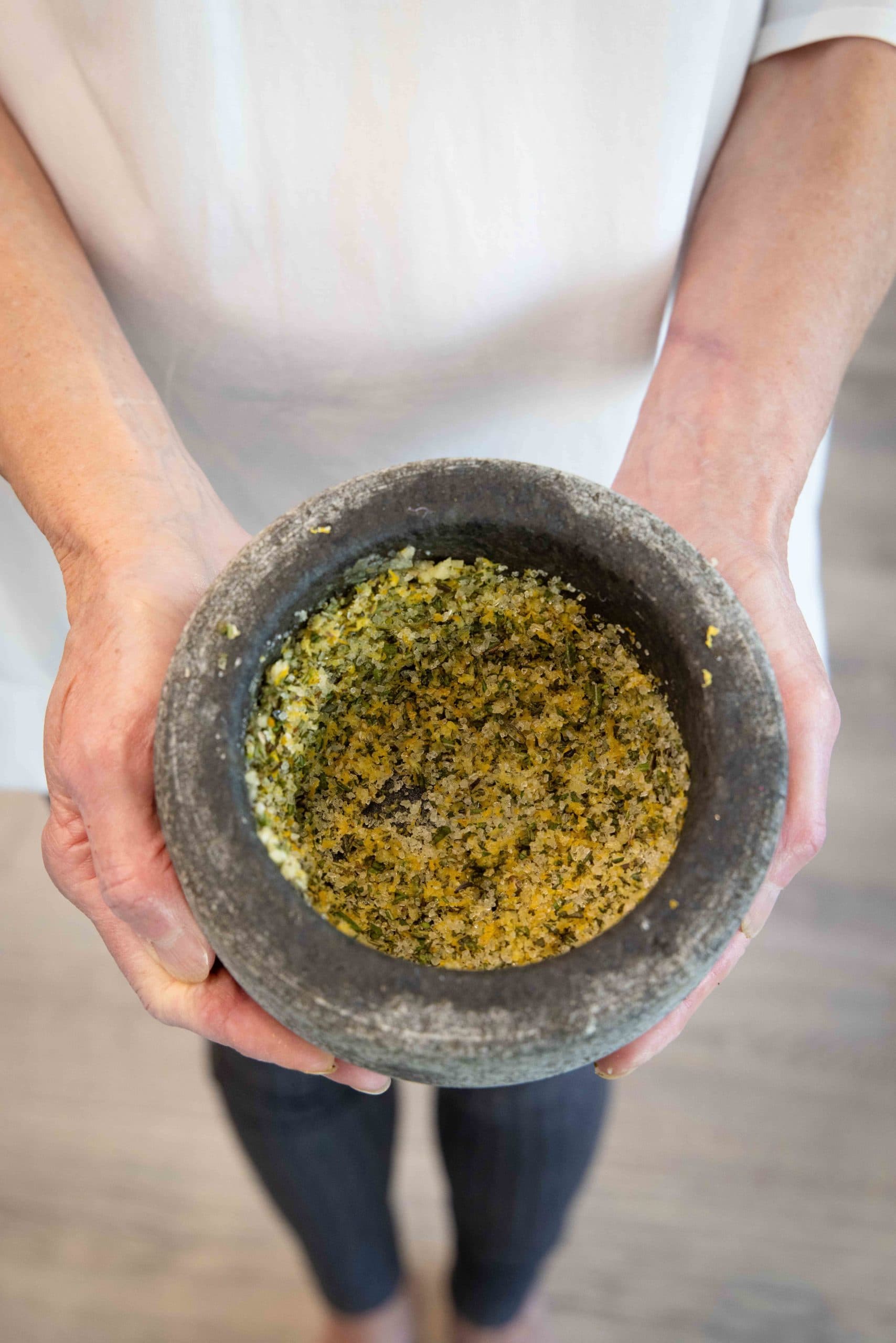
Dry Rub and Refrigerate
Rub the turkey with the dry brine blend, concentrating on the legs and breast. Sprinkle a little inside the cavity.
Place the turkey in a heavy brining bag, seal and refrigerate it. Let it rest for 2-3 days. It should look well seasoned but not overly salted.
Give the turkey a quick massage once a day (through the plastic bag) to work in the seasonings.
Drying to Crisp Skin
On Wednesday morning, remove the turkey from the bag and discard the bag. Brush off any excess salt and blot with paper towels. Do not rinse! Place the turkey on a rimmed baking sheet with a wire rack underneath.
Place the bird on the rack and put it back in the refrigerator uncovered to dry for 10-12 hours. You might have to adjust your refrigerator shelves. The drying gives you a crisp skin when roasting.
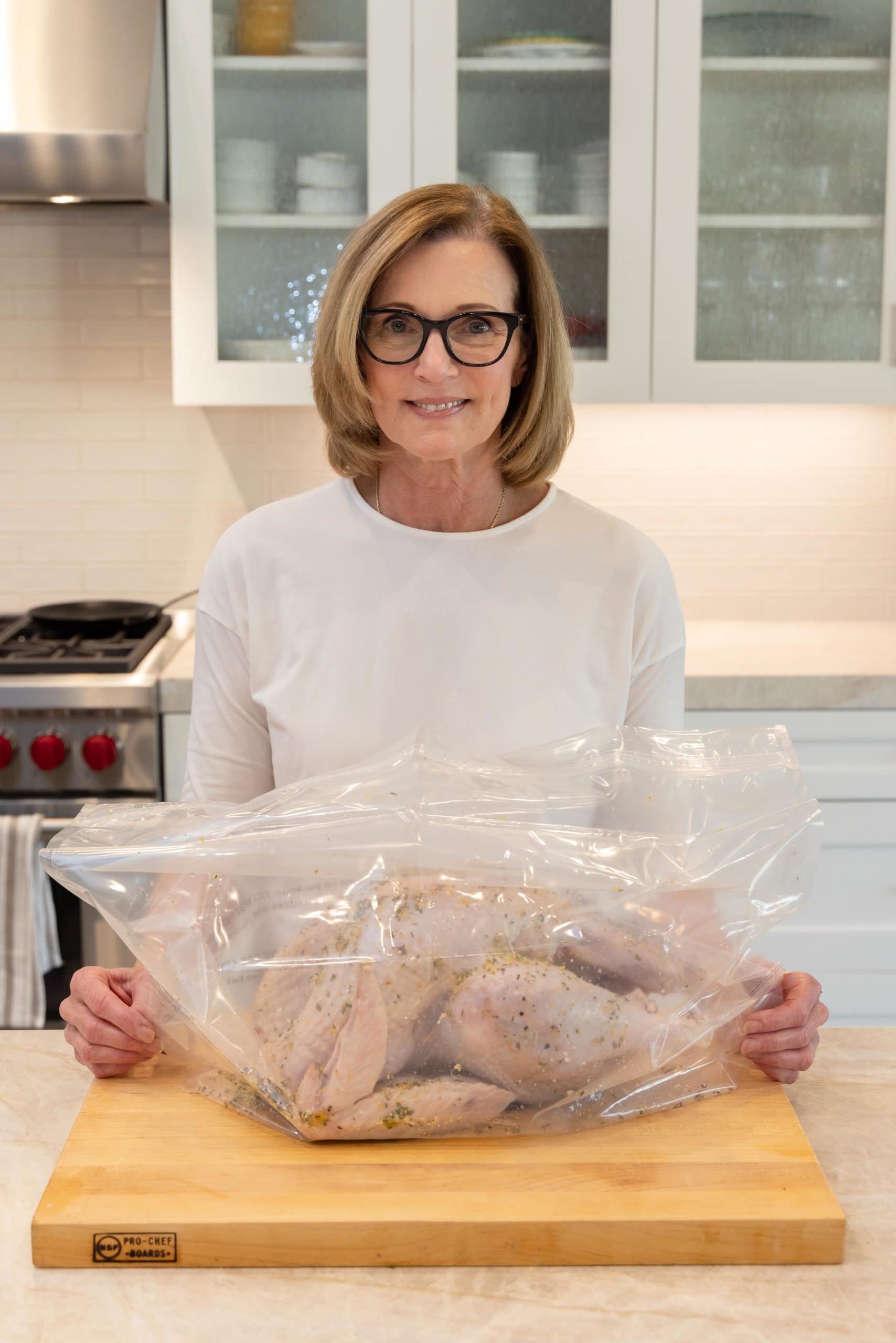
Get Ready to Roast
On Thanksgiving morning, remove the bird from the refrigerator for at least 1 hour and up to 2 ahead of time and you're ready for roasting.
How Much Turkey Per Person
If you like leftover turkey for soup, tacos, stews or casseroles, order approximately 1 ½ pounds per. This year I ordered a fresh 10 pound organic turkey. Previous years I've used a 12-14 pound bird. For a 10 pounder I started with 2 tablespoons of salt. For the 12-14 I used 2 ½ to 3 tablespoons of salt.
I recommend purchasing no more than a 12-15 pound turkey. That serves 8-10 people at 1 ½ pounds per person. They are easier to handle and roast than bigger turkey's over that weight range. For more guests, do a second turkey if you have another oven.
Fresh vs. Frozen Turkey
What about fresh versus frozen? I always order fresh (no thawing) but it depends in what is available at your market. If you buy frozen turkey it will take 1 day for every 4-5 pounds to safely thaw in the refrigerator. Proper refrigerator temperature is between 35-40 degrees.
According to the USDA Food Safety and Inspection Service (FSIS), once thawed, the turkey will be safe in the refrigerator for 1-2 days, cutting short your brining time. My advice is to get a fresh turkey. It's worth it.
Other methods of thawing such as the cold water method or the microwave method (no thanks) require cooking the turkey immediately after thawing, eliminating the ability to brine.

How I Roast Turkey
Get the Chill Off
On Thanksgiving morning remove your turkey from the refrigerator 1-2 hours before roasting. This gets the chill off and the turkey roasts better. Tuck the wings back under the body.
Make Compound Butter
Soften ½ stick of unsalted butter and mix in finely chopped fresh garlic, fresh thyme, and citrus zest to make a compound butter. Smear it under the skin of the turkey breast and over the top and legs.
Stuff the Cavity
For more flavor I stuff the cavity loosely with chopped onion, carrot, celery, whole garlic cloves and more herbs, then loosely tie the legs together with twine (better for roasting).
Roast the Turkey
Roast turkey in a roasting pan on a turkey rack to lift the bird off the bottom of the pan. I put more veggies in the bottom and eventually add enough turkey broth to the pan to keep things moist (not burned) and build good drippings for flavorful gravy.
Last note, I roast turkey at 325°F on the lower rack of the oven and do not turn the bird. Trying to turn a hot heavy turkey is not safe. It always comes out gorgeous.
Roast until a digital thermometer reads 170°F when placed in the thickest part of the thigh. Remove the turkey and let it rest tented with aluminum foil until ready to carve.
If you have any questions please ask. I'm here to help.
Chef's Tips: For tips on getting organized for a smooth Thanksgiving, read this post on my Thanksgiving Game Plan. Wear disposable kitchen prep gloves to keep hands clean when handling raw turkey. Use a microplane zester for very fine zest and wash it right after using.
Recipe FAQs
About 3 days, but if you only have 2 do it anyway, it still works.
I start mine on Sunday afternoon or Monday.
No! Do not rinse the turkey. You don't want to add any moisture that will inhibit browning for a golden crisp skin. Resist the temptation to rinse. Brush off any dry brine and pat with a paper towel.
Recipe for Turkey Side Dishes
Last note, for ideas on what to serve with your beautiful bird, try these delicious side dishes. If you do this, please let me know in the comments!
⭐️Did you Make This?
If you make this recipe, please comment and let me know, and if you loved it, please give it a 5 star rating! They really help other readers.
📖 Recipe
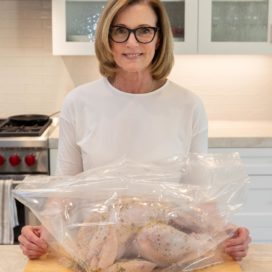
How to Dry Brine Turkey
Equipment
- A large heavy closable brining bag
- Wire rack (smaller bird on quarter sheet and larger on half sheet) for drying on Wednesday
- Enough room in your refrigerator
- Rimmed baking sheet quarter or half sized
Ingredients
Dry Brine
- 2 ½ tablespoons Kosher sea salt or pink sea salt
- 1 ½ tablespoons fresh chopped rosemary
- 1 ½ tablespoons fresh chopped thyme leaves
- 1 large orange, zested
- 1 large lemon, zested
- 2 garlic cloves, chopped
Turkey
- 12-15 pound fresh turkey
- ½ stick UNSALTED butter dairy or plant-based, for roasting
Instructions
Make the Dry Brine
- Add the salt, rosemary, thyme, citrus zests and garlic to a mortar. Using the pestle, grind the mixture together to create the rub. See post photo for example if needed. If you do not have a mortar and pestle, you can use a small clean coffee/spice grinder or mash all of the ingredients together in a small bowl until well mixed and fine, or use a mini food processor.
Dry Brine the Turkey (2-3 days)
- Remove the turkey from the plastic covering over a sink or on a rimmed baking sheet to cartch any raw juices. Rinse the turkey under cool water and pat dry with paper towels. Place the turkey in a large heavy plastic brining bag. Reach in with your hand and sprinkle the rub over the turkey concentrating on the breast and legs, then sprinkle a little inside the cavity. The turkey should look well seasoned but not overly salted. Seal the bag well. Place on a clean rimmed baking sheet and place in the refrigerator for 2-3 days, massaging the rub into the turkey once a day.
Wednesday, Drying the Turkey
- The day before roasting (Wednesday for Thankgiving) remove the turkey from the bag and discard. Brush off the salt rub and pat dry with paper towels. Place the brined turkey on a wire rack positined on a rimmed baking sheet and dry the bird uncovered in the refrigerator overnight. T
Thursday Roasting
- Thursday, the day of roasting, remove the turkey from the refrigerator 1-2 hours before roasting to get the chill off then proceed with roasting. For a compound butter recipe please see notes below.
Notes
- To calculate the dry rub for a larger or smaller turkey, use 1 tablespoon of kosher sea salt or pink sea salt for every 5 pounds of turkey and adjust the herbs and other ingredients up or down.
- For how to roast the turkey and the additional vegetables and broth you will need, please read the post. Extra onion, carrot, celery, herbs, citrus, garlic.
- Compound Butter Recipe (optional before roasting):
- Allow ½ stick of unsalted butter to stand on the counter to soften, 1 hour. Mix in finely 1-2 cloves of finely zested or chopped fresh garlic, 2 teaspoons fresh chopped thyme, a tablespoon of finely chopped shallot (optional) and extra citrus zest creating a compound butter. Smear it under the skin of the turkey breast and over the top and legs before roasting.




Comments
No Comments